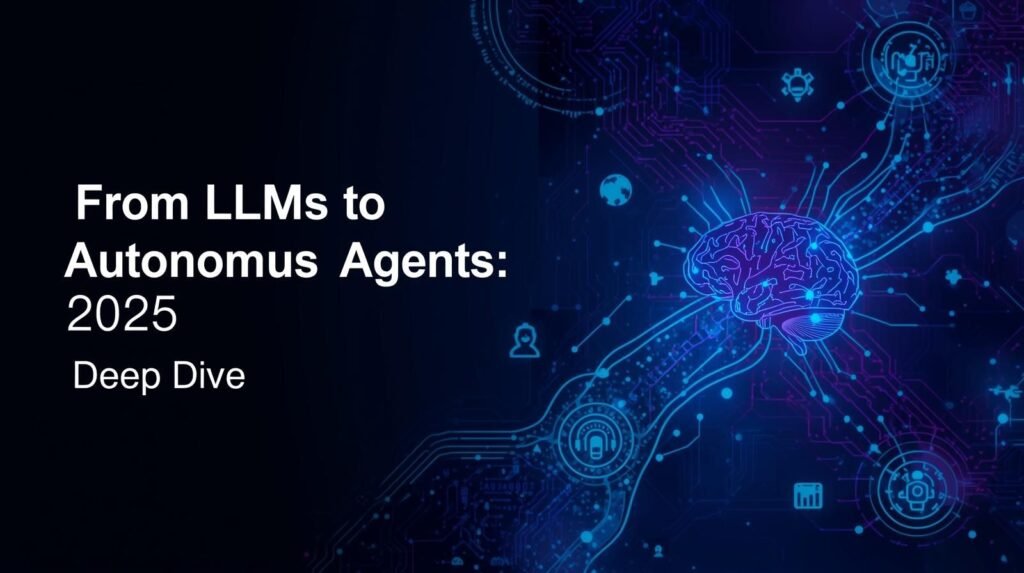
If you still think AI is just “input → nice answer,” you’re stuck in the 2023 mindset.
The real evolution happened between 2024–2025, when AI jumped from LLMs (Large Language Models) to Autonomous Agents.
LLMs could talk.
Agents can act.
This shift changed AI from a passive assistant into an active problem-solver capable of planning, executing tasks, and interacting with real systems.
1. What LLMs Could Do — and Where They Hit the Wall
LLMs Could:
Generate text
Follow instructions
Assist with reasoning
Write or debug code
Answer questions across domains
LLMs Could Not Do:
Execute multi-step workflows
Maintain long-term memory
Use external tools reliably
Self-correct errors
Initiate tasks on their own
In short:
LLMs = Conversation.
Autonomous Agents = Completion of real tasks.
This capability gap demanded the next evolution.
2. What Triggered the Rise of Autonomous Agents?
The shift wasn’t accidental. Several breakthroughs forced the industry to go beyond plain LLMs:
a) Tool Use & API Integration
Once AI models could:
call APIs
run code
interact with browsers
access databases
…AI finally got “hands” to perform work.
b) Memory Systems
LLMs forgot everything beyond the immediate session.
Agents introduced:
short-term memory
long-term vector memory
episodic task memory
This unlocked continuity and learning.
c) Self-Reflection Feedback Loops
Autonomous Agents don’t just output answers; they:
check their own work
detect mistakes
retry and optimize
This iterative loop made them far more reliable.
d) Multi-Agent Collaboration
One agent = one worker.
Multiple agents = a digital team with planners, executors, reviewers, and evaluators.
This enabled complex workflow automation.
3. How the Architecture Changed: LLM → Agentic AI
Old LLM Flow
Prompt → Model → Output
Simple, linear, limited.
Agent Architecture
Goal → Plan → Retrieve Memory → Execute via Tools → Self-Evaluate → Iterate → Final Result
Core components include:
1. Planning Engine
Breaks a high-level goal into actionable steps.
2. Reasoning Module
Figures out dependencies, order, and constraints.
3. Memory Layer
Stores past tasks, context, facts, and decisions.
4. Action System
Runs scripts, calls APIs, performs calculations, or manipulates files.
5. Self-Check Layer
Evaluates output quality and fixes errors.
This is why agents behave more like workers, not chatbots.
4. Real-World Use Cases: This Is Already Happening
Business
Automated lead qualification
AI-driven customer support
Contract drafting and review
Financial reconciliation and reporting
Software Development
Autonomous code agents
Automated pull requests
Documentation generation
Testing and CI workflows
Healthcare
Report drafting
Medical reasoning assistants
Insurance claim automation
E-Commerce
Product listing automation
Competitive price analysis
Inventory intelligence agents
Agents are already saving companies thousands of work hours.
5. Why LLMs Alone Could Never Do This
LLMs operate in a single forward pass — they respond but don’t think in steps.
Agents introduced:
planning
chain-of-thought reasoning
retry cycles
context preservation
tool execution
LLMs are reactive.
Agents are proactive.
This fundamental difference is why agents feel “intelligent.”
6. Why This Shift Matters to You
If You’re a Developer:
Skills must evolve from “prompting” to:
building agent workflows
integrating tools
designing memory systems
orchestrating multi-agent pipelines
If You Run a Business:
Your competitors will adopt autonomous AI to cut costs and speed up work.
If you don’t, your operational efficiency gap grows every month.
If You’re a Student or Creator:
This shift defines the next decade of AI jobs, startups, and innovation.
7. The Hard Truth
People keep asking:
“Will AI replace humans?”
Wrong question.
The real question is:
“How much of your work can autonomous agents automate today?”
If the answer is “a lot,” you need to adapt now — not later.
8. What Comes After Agentic AI? (Near-Future Predictions)
Expect rapid evolution into:
Self-improving agents
Human–AI hybrid work teams
AI employees with roles
Multi-agent coordination systems
Agents integrated with robots & IoT
LLMs were phase one.
Agents are phase two.
Autonomous ecosystems will be phase three.
Conclusion
LLMs made AI intelligent.
Autonomous Agents made AI useful.
The shift from LLMs to Agentic AI transformed AI from a passive text generator into an active worker capable of planning, problem-solving, and executing tasks in the real world.
If you want to stay ahead in the AI economy, understanding — and using — Autonomous AI Agents is no longer optional.

